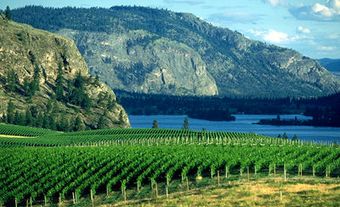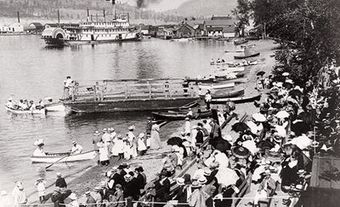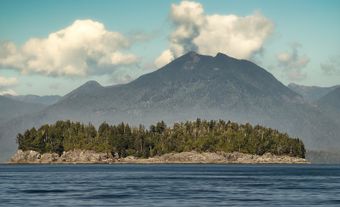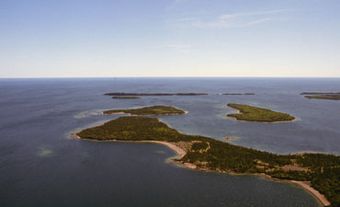Ecology
Okanagan Lake is an oligotrophic lake, meaning algae and plant growth is limited. The shallower portions at either end of the lake tend to have the most plant growth, in part because in these sections water from the bottom of the lake mixes better with water from the top, thus circulating nutrients. In the lake’s deeper portions, the water at the bottom does not mix well with surface water.
Large amounts of sediment, as a result of the most recent deglaciation of the region approximately 10,000 years ago, are the reason for the lake’s variable depth. In some areas, sediment can approach 800 m in depth. If the sediment were to be completely removed down to the bedrock, the depth of the resulting valley, from bedrock to the top of the surrounding plateaus, would exceed the depth of the Grand Canyon in Arizona.
Although deep, with limited mixing between water at the bottom and water at the top, Okanagan Lake is still home to several fish species, including kokanee, burbot, rainbow trout and lake whitefish. However, due to the relatively recent introduction of mysis shrimp to the area, some fish stocks have declined. The shrimp were initially introduced in 1966 as an attempt to provide food for kokanee and rainbow trout, but their population grew rapidly, and they now out-compete the fish for food. Community groups and government have reported some success in recent endeavours to remove the shrimp and subsequently increase fish populations.

Surrounding Okanagan Lake are extremely fertile terraces, which, like the lake’s sediment, are a result of the region’s most recent deglaciation period. As the glacier receded and water levels dropped, the lakebed sediments were exposed, leaving fertile land. The terraces are now home to orchards and vineyards; the Okanagan Valley is renowned for its wines and tree fruit. Since the Okanagan Valley is a semiarid region, a significant amount of irrigation is required in many areas, with much of the water being drawn from the rivers draining into the lake, as well as from the lake itself. In general, there is a lack of water available in the Okanagan basin for any type of use, since most of the sources on the surface, such as lakes and rivers, are allocated for purposes like industry or municipal services. The region has the lowest per-person supply of water in Canada.
Environmental Concerns
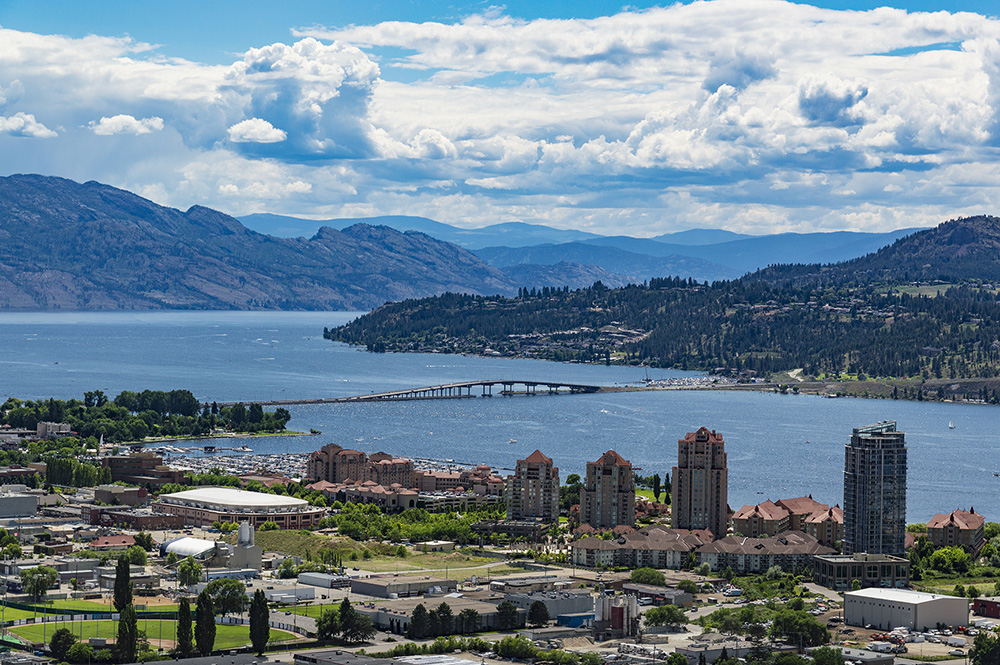
There are three major population centres located along the lake's shores: Vernon at the north end, Kelowna at the midpoint and Penticton at the south end. Despite the presence of agriculture in these regions, which typically introduces pollutants such as pesticides and animal waste into water bodies, Okanagan Lake’s water quality remains relatively good. This is in part due to the economic importance of tourism in the region; good water quality helps to draw more visitors. Similarly, Okanagan Lake is better studied and monitored than most lakes, in part due to the tourism industry but also because of the scarcity of water in the region.
Due to a combination of factors, fish stocks, specifically kokanee, have decreased over the last three decades. The factors contributing to their decline include the introduction of invasive species, the destruction of spawning habitat and the withdrawal of water for irrigation purposes. Some mining operations, in addition to wood-related industries (both primary and secondary processing) are present in the region and may have an impact on both the quality and the quantity of water in the lake. Contaminants from municipalities have decreased due to the installation of improved wastewater treatment plants in the communities of Kelowna, Vernon and West Kelowna.
History

Okanagan Lake is located within the traditional territory of the Okanagan people, also known as the syilx, who lived on this land for thousands of years prior to the arrival of Europeans. The lake and its connecting rivers were important transportation routes. The Okanagan were also active fishermen, using the lake for food and trade. They acknowledge that the lake has a spirit — their interpretation of the mythical Ogopogo creature — and see themselves responsible for caring for the lake’s sacred waters. To this end, the Okanagan Nation Alliance plays an active role in the stewardship and management of the lake.
In this episode of The Secret Life of Canada, Leah and Falen explore the truth behind two very old stories. Sasquatch and Ogopogo are legendary creatures of land and sea — but how exactly did they go from sacred figures in Indigenous oral histories to terrifying beasts and dopey-looking mascots?
Note: The Secret Life of Canada is hosted and written by Falen Johnson and Leah Simone Bowen and is a CBC original podcast independent of The Canadian Encyclopedia.
Today, the Okanagan Nation is made up of eight member bands, seven of which are located in Canada, and three of which are located along Okanagan Lake.
David Stuart of the Pacific Fur Company opened the area to the fur trade in 1811. Missionaries, gold seekers and ranchers followed. The size and depth of the lake allowed it to serve as a means for transporting goods and people to the communities dotted along its shores. Starting in the 1890s, steamboats were active on the lake, including the SS Sicamous, once owned by the Canadian Pacific Railway and now a museum located on the downtown shoreline of Penticton. Travel from the east and west shores of the lake was made easier in 1958 when a bridge was erected, joining the communities of Kelowna and West Kelowna. The original structure has since been replaced in 2008 by the William R. Bennett Bridge.

 Share on Facebook
Share on Facebook Share on X
Share on X Share by Email
Share by Email Share on Google Classroom
Share on Google Classroom
